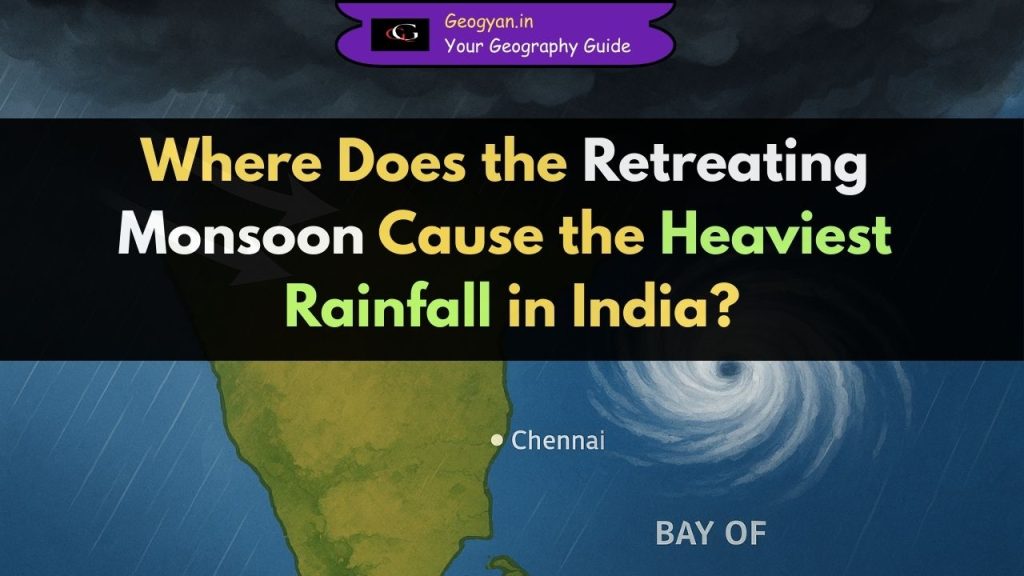Estimated reading time: 4 minutes

Table of contents
- What is the Retreating Monsoon?
- Where Does the Retreating Monsoon Cause the Heaviest Rainfall?
- Why Tamil Nadu Gets Maximum Rainfall During Retreating Monsoon?
- How is Retreating Monsoon Different from Southwest Monsoon?
- Which Regions Receive Moderate Retreating Monsoon Rainfall?
- Why is the Retreating Monsoon Important?
- Quick Exam Facts
- FAQs
- Also Read
The retreating monsoon season in India generally occurs between October and December, when winds reverse from land to sea. Recently, Typhoon Ragasa that struck Taiwan and South China (September 2025) reminded us how tropical storms influence rainfall in the Bay of Bengal and nearby regions. Similarly, India’s retreating monsoon often intensifies rainfall in the southeastern coastal states, especially Tamil Nadu.
What is the Retreating Monsoon?
The retreating monsoon marks the withdrawal of the Southwest Monsoon from northwestern India by late September, progressing south-eastward. By October, the monsoon system completely withdraws from the northern plains but continues to affect the eastern coast of Peninsular India.
It is often linked with cyclonic disturbances in the Bay of Bengal, which cause heavy rainfall in Tamil Nadu, coastal Andhra Pradesh, and Puducherry.
Where Does the Retreating Monsoon Cause the Heaviest Rainfall?
The heaviest rainfall during the retreating monsoon occurs along the southeastern coast of India, mainly in Tamil Nadu, Puducherry, and coastal Andhra Pradesh. Tamil Nadu is the clear hotspot because nearly 50–60% of its total annual rainfall comes during October–December, which is unlike most other states that depend on the Southwest Monsoon.
- Tamil Nadu (Chennai, Cuddalore, Nagapattinam, Thanjavur, Ramanathapuram): Faces torrential downpours often accompanied by cyclonic storms from the Bay of Bengal.
- Coastal Andhra Pradesh (Nellore, Vishakhapatnam, Ongole): Experiences heavy rains due to landfall of cyclones.
- Puducherry: Records intense showers as northeast winds directly strike its coast.
For instance, Chennai received over 1000 mm of rainfall in November 2015, which caused severe flooding. Such extreme events highlight how retreating monsoon rainfall can sometimes surpass southwest monsoon intensity in localized areas.
Why Tamil Nadu Gets Maximum Rainfall During Retreating Monsoon?
Tamil Nadu’s rainfall pattern is unique compared to most of India. The Western Ghats block the southwest monsoon winds, leaving Tamil Nadu in the rain-shadow zone during June–September. As a result, it receives very little rain during that season.
During October–December, the northeast trade winds reverse direction and blow from land to sea. While crossing the warm Bay of Bengal waters, they absorb huge amounts of moisture. When these winds hit the Tamil Nadu coastline, they release this moisture as heavy rainfall.
Additional facts:
- Cyclonic storms in the Bay of Bengal, often formed near the Andaman Sea, move westward and intensify rainfall in Tamil Nadu.
- Districts like Nagapattinam, Cuddalore, and Chennai regularly face flood-like situations during strong retreating monsoons.
- Tamil Nadu is the only major state in India that depends more on retreating monsoon rainfall (50–60%) than southwest monsoon rainfall (10–20%).
This makes the retreating monsoon not just a seasonal event but a lifeline for agriculture and water security in Tamil Nadu, especially for crops like paddy, sugarcane, and pulses.
How is Retreating Monsoon Different from Southwest Monsoon?
| Feature | Southwest Monsoon (June–Sept) | Retreating Monsoon (Oct–Dec) |
| Direction | Southwest to Northeast | Northeast to Southwest |
| Rainfall | Heavy in Western Ghats, Northern Plains, NE India | Heavy in Tamil Nadu, Coastal Andhra, Puducherry |
| Cause | ITCZ shift, Arabian Sea & Bay of Bengal branches | Cyclonic storms in Bay of Bengal |
| % of Annual Rainfall | 70–90% in most regions | 50–60% in Tamil Nadu |
For exams, remember that Tamil Nadu is the only major Indian state that depends more on retreating monsoon rainfall than the southwest monsoon.
Which Regions Receive Moderate Retreating Monsoon Rainfall?
- Andhra Pradesh (coastal districts) – Vishakhapatnam, Nellore.
- Karnataka (interior regions) – experiences light showers.
- Kerala (southern tip) – minimal rainfall during this period.
Why is the Retreating Monsoon Important?
- Agriculture in Tamil Nadu (paddy cultivation depends on this rainfall).
- Water supply for Chennai and other urban areas.
- Cyclone preparedness in coastal Andhra, Odisha, and Puducherry.
Quick Exam Facts
- Tamil Nadu gets 50–60% of annual rainfall from retreating monsoon.
- Retreating monsoon is also called the Northeast Monsoon.
- Bay of Bengal cyclones are common during this season.
- Chennai floods of 2015 are linked to extreme retreating monsoon.
- Kerala and Western Ghats remain mostly dry in this period.
FAQs
Q1. Which state receives maximum rainfall from the retreating monsoon?
Tamil Nadu receives the maximum rainfall, especially in Chennai, Nagapattinam, and Thanjavur districts.
Q2. Why does the retreating monsoon cause cyclones?
The Bay of Bengal is warm during October–November, which fuels low-pressure systems that intensify into tropical cyclones.
Q3. What is the difference between Southwest and Retreating Monsoon rainfall?
The Southwest Monsoon dominates most of India, while the retreating monsoon is crucial for Tamil Nadu and coastal Andhra Pradesh.




























